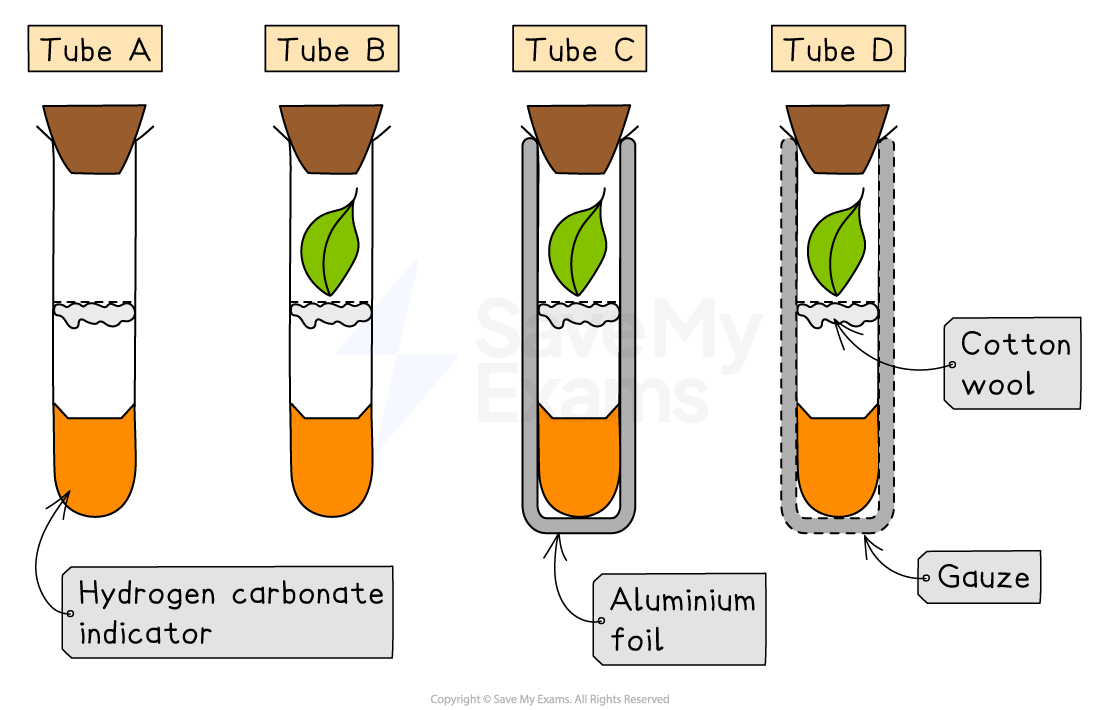Practical: The Effect of Light on Gas Exchange in Plants (Edexcel IGCSE Biology): Revision Note
Exam code: 4BI1
Did this video help you?
Practical: The Effect of Light on Gas Exchange in Plants
This experiment investigates how light affects photosynthesis and respiration by showing changes in carbon dioxide levels around a leaf:
Plants photosynthesise in light, using carbon dioxide
Plants respire all the time, producing carbon dioxide
By comparing leaves in different light conditions, we can see the net gas exchange
Hydrogen-carbonate indicator changes colour depending on CO₂ concentration:
Yellow → high CO₂ (more acidic)
Orange/red → normal CO₂
Purple → low CO₂ (less acidic)
Apparatus
Boiling tubes
Cotton wool
Aluminium foil
Muslin (thin cotton cloth)
Rubber bungs
Hydrogen-carbonate indicator
Leaves
Method
Measure out 20 cm3 hydrogen-carbonate indicator into each of 4 boiling tubes
Put some cotton wool into each boiling tube
Label the boiling tubes A-D and set them up as follows:
Tube A - No leaf (control tube) left in bright light
Tube B - Place a leaf in the tube and leave in bright light
Tube C - Place a leaf in the tube and wrap the tube in aluminium foil to block out light (leaf will be in the dark)
Tube D - Place a leaf in the tube and wrap it in muslin (thin cotton cloth) to allow some light through
Put a bung into the top of each tube
Leave all 4 tubes in the light for several hours/overnight
Observe any colour changes in the hydrogen-carbonate indicator

Hydrogen-carbonate indicator can be used to study gas exchange in different light conditions - it is usually orange in normal atmospheric conditions
Results
After several hours/overnight, we would expect the following results:
Tube A - The control tube should remain an orange colour to show that the carbon dioxide is at atmospheric levels
There has been no net movement of carbon dioxide
Tube B - This tube was placed in the light with a leaf which is photosynthesising and respiring
Because the rate of photosynthesis is greater than the rate of respiration, the hydrogen-carbonate indicator will turn purple as there is less carbon dioxide than atmospheric levels
Tube C - This tube had a leaf inside, but was wrapped in aluminium foil meaning that no sunlight could reach the leaf
No light means that this leaf will not photosynthesise but will still be respiring, producing carbon dioxide. The indicator will turn yellow as carbon dioxide levels increase above atmospheric levels
Tube D - This tube had a leaf inside and was wrapped in muslin (cotton cloth) allowing some light through
This means that the rate of photosynthesis is roughly balanced with the rate of respiration, although usually the rate of photosynthesis is slightly greater so there may be a very small net change in carbon dioxide levels and the indicator either remains orange, but it could turn slightly purple.
Any colour change will be much less dramatic than the tube in bright light

Hydrogen-carbonate indicator will change from orange to yellow with increasing carbon dioxide or purple with decreasing carbon dioxide
The Effect of Light on Net Gas Exchange in Plants Table
Boiling tube label | Conditions | Initial colour of hydrogen-carbonate indicator | Final colour of hydrogen-carbonate indicator | Conclusion |
|---|---|---|---|---|
Tube A | No leaf (control) | Orange | Orange | No respiration or photosynthesis so no net movement of CO2 |
Tube B | Leaf in sunlight | Orange | Purple | Photosynthesis > respiration. There is a net intake of CO2 . The level of CO2 decreases. |
Tube C | Leaf wrapped in aluminium foil | Orange | Yellow | No photosynthesis due to lack of light, only respiration occurs. |
Tube D | Leaf wrapped in muslin (cotton cloth) | Orange | Orange/slightly purple | Photosynthesis and respiration are relatively balanced. Net exchange of gas is small, although photosynthesis may exceed respiration so a small net update of CO2 may happen (level of CO2 decreases) |
Applying CORMS evaluation to practical work
When designing or reviewing practical investigations, remember to consider the CORMS prompt

The CORMS prompt
For this investigation into the effect of light on net gas exchange from a leaf using hydrogen-carbonate indicator, the following would apply:
Change - change the availability of light for each boiling tube (not wrapped, wrapped in foil, wrapped in muslin)
Organisms - the leaves should be from the same species/age of the plant, they should be approximately the same size
Repeat - repeat the investigation several times to ensure results are reliable
Measurement 1 - observe the change in the hydrogen-carbonate indicator
Measurement 2 - after several hours/overnight
Same - control the volume of hydrogen-carbonate indicator, the number of leaves, the temperature of the environment

Unlock more, it's free!
Did this page help you?